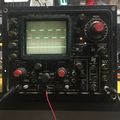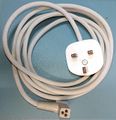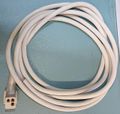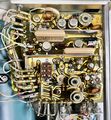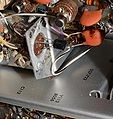422
The Tektronix Type 422 is a 15 MHz portable dual-trace oscilloscope introduced in 1966. It was available with an optional battery back for operation without mains power.
Key Specifications
| Bandwidth | DC to 15 MHz |
|---|---|
| Risetime | < 23 ns |
| Sweep | 500 ns/div to 0.5 s/div |
| Input impedance | 1 MΩ ±2% // 30 pF |
| Delay line | 150 ns, internal delay line |
| Input voltage | Max. 300 V combined DC and peak AC |
| Trigger source | CH1 & CH2, CH1, External |
| Channel isolation | 100:1 at 40 KHz |
| Calibrator | ~1 kHz ±20%, 2 V ext jack, 0.2 V internal, square wave |
| CRT | T4220 tube, P31 phosphor, 6 kV acceleration (Post-def 4.9 kV), 8 × 10 graticule, 0.8 cm/div |
| Operating temperature | –15 °C to +55 °C |
| Power | AC PS, 110/115/125 or 210/230/250 VAC ±10%, 45 Hz to 440 Hz, 40 W AC-DC PS, 92–137 or 184–274 VAC, 45 Hz to 440 Hz, 11.5–35 V DC, 30 W |
| Dimensions | AC PS (H/W/D) 6.75/10.0/17.8 inches, AC-DC PS (H/W/D) 6.75/10.0/20.7 inches |
Links
Documents Referencing 422
| Document | Class | Title | Authors | Year | Links |
|---|---|---|---|---|---|
| Tekscope 1969 V1 N4 Aug 1969.pdf | Article | Nickel-Cadmium Battery Rev1ew | 1969 | 321A • 323 • 410 • 422 |
Internals
Early versions use an 8056 Nuvistor tube for the front-end cathode follower. Later versions use a FET front end. The 8056 Nuvistor used in the input amplifier of the 422 can be replaced by a MPF102 JFET.
The trigger circuit in the 422 has a trigger amplifier driving a 1N3719 tunnel diode, D375, which acts as a Schmitt trigger. The trigger amplifier has a nonlinear deadband diode circuit in the negative feedback path. What results is high gain for small signals (little or no negative feedback) and low gain for large signals (strong negative feedback). Thus, the signal at the base of Q364 has a limited swing over a wide range of input amplitudes. The collector current of Q364 varies between 0 and 9 mA. Depending on the position of the trigger slope control, higher collector current in Q364 either switches D375 from the low-voltage state to the high-voltage state or from the high-voltage state to the low-voltage state. When D375 transitions from the low-voltage state to the high-voltage state, it produces a current pulse in the primary of transformer T401, which produces a current pulse in the secondary of T401. The secondary of T401 feeds another tunnel diode, D405, and the current pulse switches D405 to the high-voltage state, which starts a sweep.
The 422 uses the T4220 CRT.
Pictures
External
-
-
-
Rear face of 422 without DC battery option
-
R422, compartment closed
-
R422, compartment open
-
Black 422, panel mount
-
-
422 trace is sharp
-
422 in ALT
-
-
-
-
-
AC Power Cord with UK Plug
-
DC Power Cord
Internal
-
Tek 422 Internal LHS
-
Tek 422 Internal RHS
-
Tek 422 Internal Top
-
Tek 422 Internal Rear
-
Tek 422 Internal Underside
-
Tek 422 Internal V-Amp
-
Tek 422 H-Amp Board
-
Tek 422 Trigger Board
-
Tek 422 Input Board#1
-
Tek 422 Input Board#1
-
Tek 422 Indicator unit - Regulator
-
Tek 422 HV Case
-
Tek422 AC Power Supply Module
-
Tek 422 AC Power supply Internal
-
Tek 422 AC Power supply Internal
-
Tek 422 AC Power supply Internal
-
Tek 422 AC Power supply Internal
-
Tek 422 AC Power supply Internal
-
-
-
-
-
-
-
-
-
-
Tek 422 Indicator unit, Power supply Test points
Schematic
-
Trigger circuit
-
Sweep circuit
-
Vertical amplifier circuit
-
Input amplifier circuit
-
Horizontal amplifier circuit
-
CRT circuit
-
ac-dc power supply
-
ac power supply
Components
Some Parts Used in the 422
| Part | Part Number(s) | Class | Description | Used in |
|---|---|---|---|---|
| 1N3714 | 152-0081-00 | Discrete component | 2.2 mA, 25 pF germanium tunnel diode | 546 • 547 • 556 • 21A • 22A • 3B1 • 3B2 • 3B3 • 422 • 491 • 283 |
| 1N3719 | 152-0182-00 | Discrete component | 10 mA, 50 pF germanium tunnel diode | 422 • 661 • 7B92 • 7B92A |
| 8056 | 154-0417-00 | Vacuum Tube (Triode) | low-voltage Nuvistor triode | 422 • 502 • W • 1S1 • 3A7 • 3S3 • 3T4 • 5T3 • 10A1 |
| STD933 | 152-0181-00 | Discrete component | 1 mA, 5 pF germanium tunnel diode | 1S2 • 221 • 422 |
| T4220 | 154-0466-00 • 154-0466-05 | CRT | rectangular 3⅜ × 3⅞ flat-faced CRT | 422 |
| TD714 | 152-0402-00 | Discrete component | 2.2 mA, 25 pF tunnel diode | 1401 • 1401A • 283 • R283 • 3B2 • 3B3 • 422 • 491 • 546 • RM546 • 547 • RM547 • 556 • RM556 • SPG11 • SPG12 |
| ZZ1000 | 154-370 • 154-0370-00 | Gas Discharge Tube (Voltage regulator) | 81 V voltage reference | 129 • 3B1 • 3B1S • 3B2 • 3B3 • 3S76 • 422 • S-311 |






